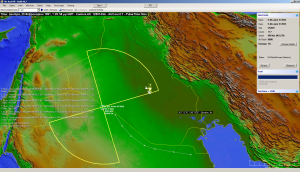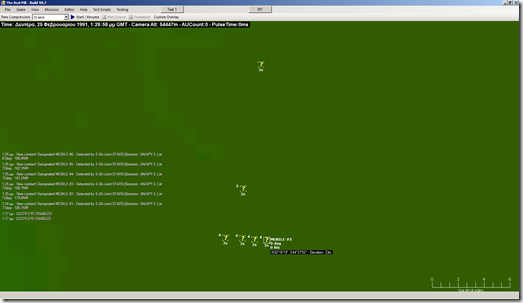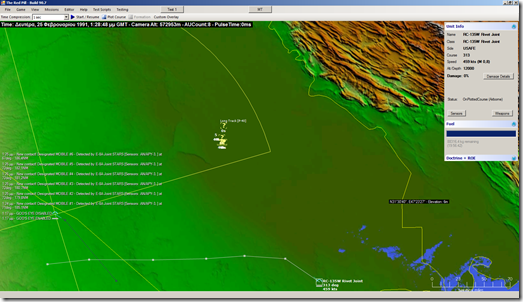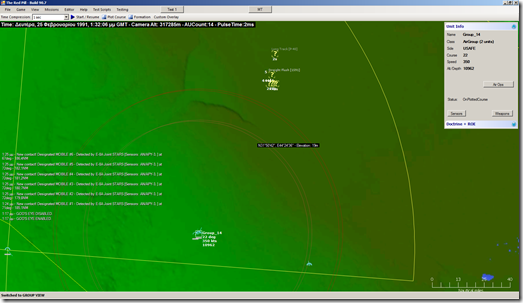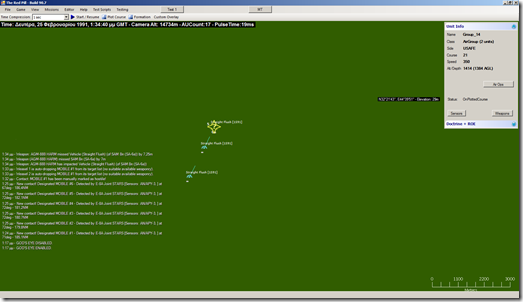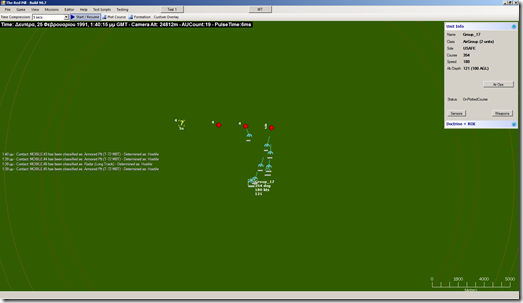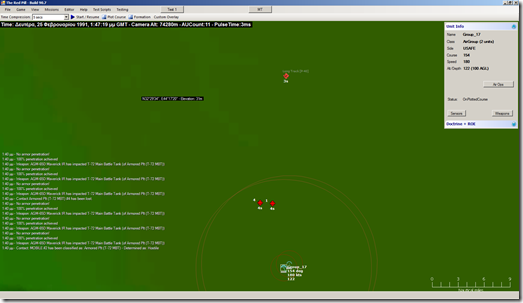Red Pill screenshots #6: Wild weasels and ground-pounders
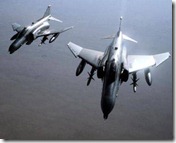 Monday, February 25th 1991, over the Saudi-Iraqi border…
Monday, February 25th 1991, over the Saudi-Iraqi border…
The conflict is gradually winding down to its conclusion, the surviving elements of Iraqi forces retreating to pre-war positions without offering any resistance to coalition ground troops.
The J-STARS patrol over the border, however, has spotted a previously undetected group of vehicles:
(The green hues are not representative of vegetation; we are using the terrain relief map layer to easily depict terrain elevation. The majority of Iraq is flat desert, hence the green shades. Note the significantly more rugged, mountainous terrain of neighboring Iran.)
Zooming in on the detected units we can see that they consist of four 4-vehicle groups (Truck sections? Tank platoons?), a five-vehicle cluster to their north and a single vehicle north of both of them:
It is decided to send a two-ship A-10A section to investigate and engage if necessary. While the Hogs are being prepared and launched, an RC-135W snooper orbiting in the region is diverted closer to the investigated area for an ELINT sweep:
The northernmost vehicle seems to be emitting with at least one Long Track radar:
(One of the recent improvements to the ESM model is the addition of “emission lists” on top of displayed contacts, which display all electronic emissions detected from each contact. Each emission fades-out as time passes from its last detection and comes up bright again as it is re-detected. Radars with high scan rates, such as radar illuminators or multi-function radars in tracking or illumination mode, refresh more frequently than search radars. Players familiar with an adversary’s electronic order of battle (EOOB) can thus very quickly evaluate the tactical situation without having to repeatedly use the detailed contact information window.)
The presence of the Long Track could potentially mean a higher threat level for the Hogs preparing to enter the unknown area: Such mobile radars are often encountered accompanying mobile SAM units. For this reason it is decided to escort the Hogs with a pair of F-4Gs equipped for defence suppression (SEAD) with HARM missiles.
So the Wild Weasels take off, form up and head to the same area, slightly ahead of the Hogs thanks to their greater cruise speed. Not long afterwards the suspicions borne by the Long Track detection are confirmed: the vehicle group sandwiched between the multiple vehicle cluster and the single vehicle is detected to be using a Straight Flush radar: Almost certainly a SA-6 battery.
The SA-6 is dangerous despite its age, so a preemptive strike with the Weasels’ HARM missiles is quickly agreed upon. The HARM can be launched in 3 modes:
1) Short-range “snapshot” direct attack – e.g. the parent aircraft detects a pop-up mobile SAM at close range, the ARM seeker locks on the emission pre-launch and the weapon is fired directly on that target.
2) Long-range targeted attack, ie. you fire the ARM in bearing-only launch (BOL) mode but specify the emission you want it to lock to. It will home only on this specific emission and nothing else. (Note though that if another SAM unit with the same emission, or even a decoy emitter, is nearby, the ARM may lock on that instead.)
3) Long-range “freehunt” attack, ie. you BOL-fire the ARM without specifying an emission to sniff for, it will simply home on any emission it detects. This is useful for preemptively saturating a suspected high-threat area (conceptually similar to plastering with artillery a hilltop that may or may not host enemy troops).
In this occasion the F-4Gs are well out of range for a “snapshot” attack (and all the happier for it – if you are close enough to lock the HARM pre-launch, you are almost certainly in the heart of the enemy SAM’s envelope). On the other hand a freehunt launch is undesirable because of the proximity of other forces in the area and the possible presence of other emitters. So a long-range targeted launch is preffered.
Both Wild Weasels tune their HARMs to the Straight Flush radar and cut loose: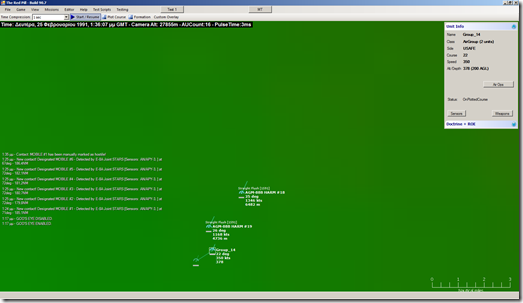
(Note that the anti-radar missiles display the emitter to which they have been tuned. This provides an immediate display of what is targeted where, which can be useful in massed attacks – particularly in freehunt launches.)
The HARMs quickly cover the distance and begin impacting on the SA-6 battery. The first pair arrives simultaneously and completely annihilates the vehicle group – unfortunately for them, the battery elements happened to be concentrated more tightly than their norm, so a couple of fragmentation explosions in their midst was all it took.
With the SAM threat neutralized, the road is open for the Hog section. The A-10s close within visual detection distance and identify their targets: They are indeed multiple T-72 platoons, perhaps carefully kept out of action as a last-attempt force. The Hogs divide up the targets among them and begin ripple-firing their Maverick missiles.
(We previously mentioned aimpoints and their use in Red Pill and this is another example of them in action: Each T-72 platoon is a single ground mobile unit that contains four unique aimpoints (the tanks), each of them with its own weapons, sensors etc. Each successful Maverick hit is likely to destroy a single tank while leaving the rest of its platoon intact. A more powerful weapon of course may produce multiple kills in one go.)
It’s all over quickly; the Hogs have exhausted their Maverick loadouts and are being recalled before they have a chance to empty their 30mm magazines. In less than a minute they fired 12 Mavericks and several 30mm bursts, destroying 11 tanks in their process. The surviving tanks and the lone Long Track radar will have to wait for the second interdiction wave.
Comments
Leave a Reply
You must be logged in to post a comment.




